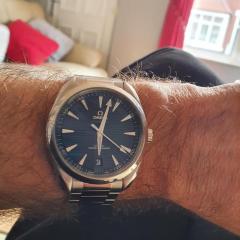-
Similar Content
-
Recently Browsing
- No registered users viewing this page.
-
Topics
-
Posts
-
By RichardHarris123 · Posted
Well done, let us know how you get on with the citizen. -
@Neverenoughwatches Rich, I can only agree with you wholeheartedly. I spend a lot of time here learning all sorts and trying to make any little contribution to help others I can. Nothing can last forever and I wish I could do more to contribute to the forum financially and any other support I could. Tom
-
This forum is a big part of my life. When I retired from horology many years ago due to poor health I missed what I had trained for. On here I can still do my bit in helping and advising others and have a little fun as well.
-
By RichardHarris123 · Posted
First thing this morning, make coffee, second, check the forum. I would really miss the forum, not on any social media, not interested in telling the world what I had for breakfast!!! I do consider most of the regulars friends and would wonder what had happened if they stopped posting. -
Hi all Thought I'd show my small and trying to keep under control watch collection! Apart from the Enicar all were under £12! At least if I destroy them in the process then I won't be too worse off. A few pics to start off with First of all my first attempt. A Thuya pocket watch. It was only running face down and would stop when vertical. So now it still works face down and only slows down when vertical so at least an improvement! 😄 I only have a generic watch oil at the mo so that won't help but I'm hoping to get some more appropriate oils in a couple of months for my birthday. I did have to get a crystal for it since it didn't come with one. It didn't look as though it would friction fit (and I don't have a crystal press in any case) so I glued it to the case with PVA. So far so good. Next up above are a sekonda and citizen automatic. Both non runners. Both with broken balance wheels amongst other things. I'm hopeful the citizen will start when I get the new one I ordered but the sekonda is being kept for spares and trial of new techniques. And finally the Enicar and the timemaster. Both running when I got them. I wanted to get running watches so that at least I stood a fighting chance of still having a running watch after the service! It was all going well on the Enicar until I dropped the balance wheel during reassembly...😔. Unfortunately they are quite expensive to get so for now I'll won't do anything with it but I would like to fix it at one point. The timemaster is still running (yeah!) but I managed to break a dial foot during the deassembly. First repair attempt failed so now I am looking at soldering it back on... So there we go. My initial foray into this great hobby. Thanks for sticking with this tale so far. I'm hoping that once the balance wheel arrives for the citizen I will be able to say I bought a non runner and fixed it! So fingers crossed. Thanks for looking, Nick
-










Recommended Posts
Join the conversation
You can post now and register later. If you have an account, sign in now to post with your account.
Note: Your post will require moderator approval before it will be visible.